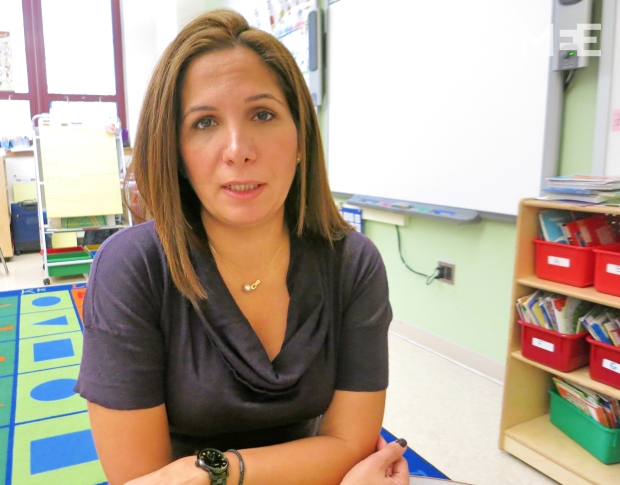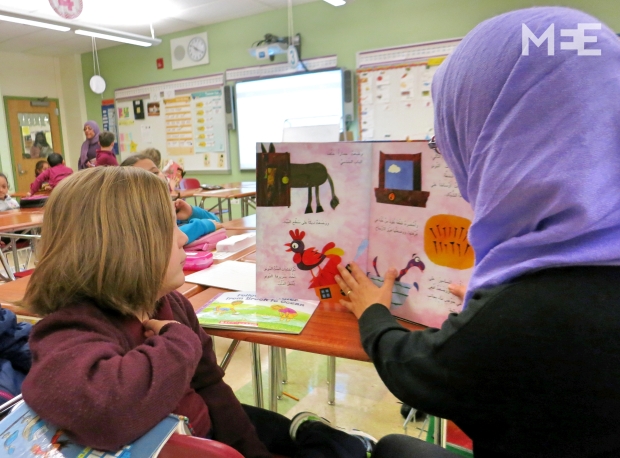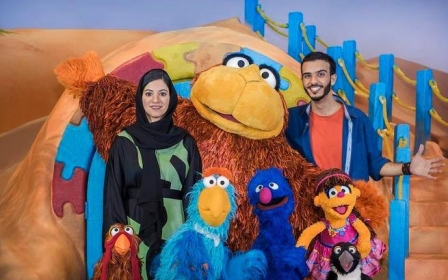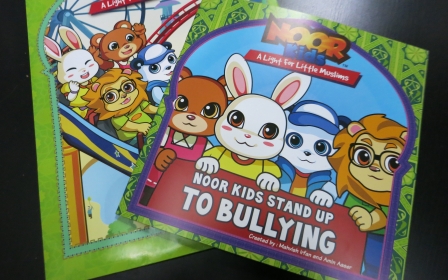Arabic gaining in US schools despite critics
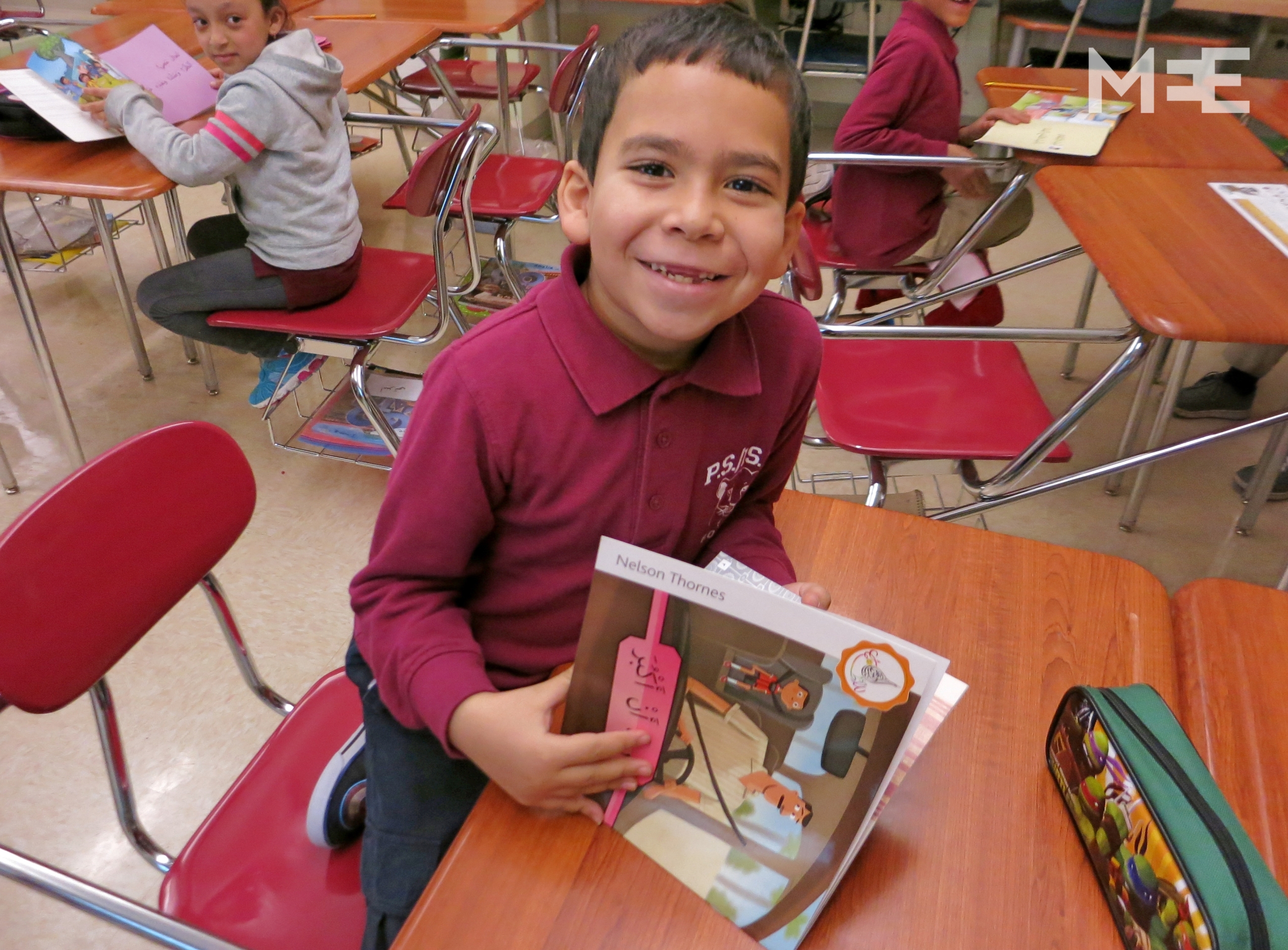
BAY RIDGE, New York – Across the US, protesters have waved banners outside of public schools that teach Arabic, warning of creeping Islamisation. The reality inside those classrooms is much less controversial.
During lessons at Mary White Ovington School in New York this week, young students read from Arabic story books, played around with cursive script and chatted about kebabs, hummus and other tasty snacks from the Middle East. Their text books were free of politics and faith; teachers focused on reading, writing, maths and science.
Less than one percent of US public schools offer Arabic, but the language is making gains despite occasional protests.
“We have never had any issues or anyone say anything negative about the programme,” Merilla Deeb, a Lebanese-American teacher at Mary White Ovington School, also known as PS/IS 30, told Middle East Eye. “We made it clear from day one that this is an Arabic-language programme. It is not about politics; it is not about religion.”
The school is located in Bay Ridge, Brooklyn - a waterfront Arab-American neighbourhood where immigrants from Egypt, Lebanon, Syria, Palestine, Jordan, Morocco, Yemen and elsewhere mix with Asians, Latinos and white-American families.
Each class of 25 students is evenly split between children who speak Arabic at home and those who use English, Spanish or another tongue.
The “immersion” programme sees half the lessons - including maths and science - taught by an Arabic-speaking teacher and the rest of the curriculum delivered in English.
“Statistics on students show that, by the time they reach third grade, students in a bilingual immersion programme outperform students in a typical monolingual, English-only classroom,” Deeb said.
In her classes, Arabic speakers help out Anglophone classmates. As well as creating polyglots, this forges bonds between Arab-Americans and other groups despite negative perceptions of the Middle East in post-9/11 America.
“Our students are now reading to learn and no longer learning to read,” Carol Heeraman, principal of the 600-pupil school for the past five years, told MEE.
“I would love to hear our students speaking, writing, reading Arabic to some fluency. Our ultimate goal is to graduate our first eighth-grade class in five years, who will hopefully be conducting their graduation ceremony in Arabic.”
While it is working out in Bay Ridge, other Arabic-language classes have been mired in controversy. When the nearby Khalil Gibran International Academy (KGIA) opened a few kilometres away in 2007, angry protesters at the gates decried the “Madrassa in Brooklyn”.
Though KGIA remains open and still teaches Arabic, it has struggled to find enough teachers and Arab-American pupils.
Pine Bush High School in upstate New York received multiple complaints in March after it allowed a student to recite the US Pledge of Allegiance in Arabic during a week of activities focused on foreign languages.
In August, some 30 protesters waved US and Israeli flags outside the new Arabic Immersion Magnet School in Houston, Texas, linking the language with Islam and the 9/11 attacks on New York and Washington.
One sign read: “Qatar out of our school,” in reference to Qatar Foundation International (QFI), a charity backed by the Gulf petro-monarchy that spends $2-5 million on Arabic classes each year in 19 US schools, including the ones in Houston and Bay Ridge.
Sara al-Hemaidi, a QFI spokesman, said critics have highlighted Qatar’s long-standing ties to the Muslim Brotherhood but that complaints at a handful of their recipient schools had not caused lessons to halt.
“You see it on individual blogs, there haven’t been any national or credible sources of critique that we’ve had to respond to,” she told MEE. “They tend to be right-wing conservatives who just hear the world Arabic and object to it.”
To some, the Arabic language is linked to Islam and the brand of religious extremism behind a wave of attacks that has seen the World Trade Centre toppled and this month 130 people murdered in Paris.
Amid fears of terrorism strikes in the wake of the Paris attacks, Republican lawmakers are trying to boost security checks on Syrian and Iraqi refugees coming to the US.
Muslim Americans have responded with frustration and anger to anti-Muslim comments from two of the Republican Party’s most popular candidates ahead of the 2016 presidential election, Ben Carson and Donald Trump. Carson said Muslims were unfit to be US president.
Despite hostility from some quarters, Arabic teachers have been welcomed in to the more cosmopolitan, urban areas where QFI-funded lessons take place. The language is making slow, steady gains in schools.
While less than one percent of pupils study Arabic at the 98,000 US elementary schools, the number has “dramatically increased over the past 15 years,” said al-Hemaidi, with scores of new programmes launching between 2006-2011.
As well as being useful for traders and diplomats, the rise of Arabic is driven by demand from Arab-American families who want their children to hang on to their heritage, Carine Allaf, who runs QFI’s schools programme, told MEE.
Also, “Arabic is a strategic and critical language, according to the US State Department, post-9/11,” Allaf said. “Some schools want students to develop cultural understanding and there are good economic reasons in terms of employment opportunities.”
Though it reaches only 2,100 students in the US, QFI has projects in Brazil, Canada and Britain and plans to grow. The goal is to “normalise and mainstream Arabic teaching” and tackle “stereotypes and media representations” of Arabs, said Allaf.
Arabic is not only making gains in classrooms, but also in the wider US population. According to census data, Arabic is the fastest-growing language in the country, with a 29 percent rise of 252,000 speakers between 2010-2014.
There are 1.1 million Arabic speakers in the nation of 319 million people.
Back at the school in Bay Ridge, some of the language’s youngest learners were struggling to master the 28 letters of the right-to-left script. According to Heeraman, the principal, they will be studying for many years to come.
“Here, we’re purely academic, just as though we’re teaching Spanish, French or Russian,” she said. “I’m not sure as to why, but I’m grateful and thankful that there isn’t any controversy and it’s being graciously accepted in the community.”
New MEE newsletter: Jerusalem Dispatch
Sign up to get the latest insights and analysis on Israel-Palestine, alongside Turkey Unpacked and other MEE newsletters
Middle East Eye delivers independent and unrivalled coverage and analysis of the Middle East, North Africa and beyond. To learn more about republishing this content and the associated fees, please fill out this form. More about MEE can be found here.


